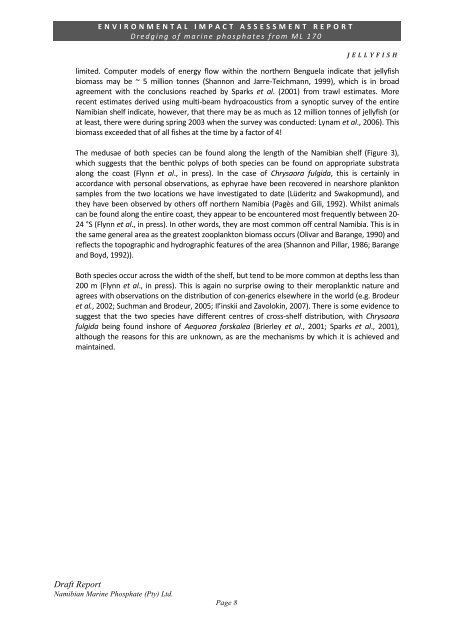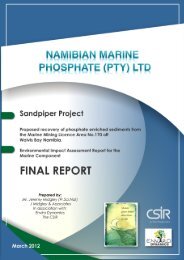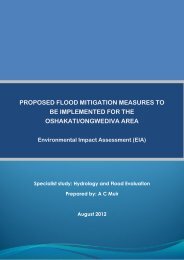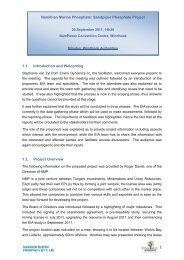Appendix 1d - Jellyfish Study.pdf - Enviro Dynamics Namibia
Appendix 1d - Jellyfish Study.pdf - Enviro Dynamics Namibia
Appendix 1d - Jellyfish Study.pdf - Enviro Dynamics Namibia
Create successful ePaper yourself
Turn your PDF publications into a flip-book with our unique Google optimized e-Paper software.
E N V I R O N M E N T A L I M P A C T A S S E S S M E N T R E P O R TD r e d g i n g o f m a r i n e p h o s p h a t e s f r o m M L 1 7 0J E L L Y F I S Hlimited. Computer models of energy flow within the northern Benguela indicate that jellyfishbiomass may be ~ 5 million tonnes (Shannon and Jarre-Teichmann, 1999), which is in broadagreement with the conclusions reached by Sparks et al. (2001) from trawl estimates. Morerecent estimates derived using multi-beam hydroacoustics from a synoptic survey of the entire<strong>Namibia</strong>n shelf indicate, however, that there may be as much as 12 million tonnes of jellyfish (orat least, there were during spring 2003 when the survey was conducted: Lynam et al., 2006). Thisbiomass exceeded that of all fishes at the time by a factor of 4!The medusae of both species can be found along the length of the <strong>Namibia</strong>n shelf (Figure 3),which suggests that the benthic polyps of both species can be found on appropriate substrataalong the coast (Flynn et al., in press). In the case of Chrysaora fulgida, this is certainly inaccordance with personal observations, as ephyrae have been recovered in nearshore planktonsamples from the two locations we have investigated to date (Lüderitz and Swakopmund), andthey have been observed by others off northern <strong>Namibia</strong> (Pagès and Gili, 1992). Whilst animalscan be found along the entire coast, they appear to be encountered most frequently between 20-24 °S (Flynn et al., in press). In other words, they are most common off central <strong>Namibia</strong>. This is inthe same general area as the greatest zooplankton biomass occurs (Olivar and Barange, 1990) andreflects the topographic and hydrographic features of the area (Shannon and Pillar, 1986; Barangeand Boyd, 1992)).Both species occur across the width of the shelf, but tend to be more common at depths less than200 m (Flynn et al., in press). This is again no surprise owing to their meroplanktic nature andagrees with observations on the distribution of con-generics elsewhere in the world (e.g. Brodeuret al., 2002; Suchman and Brodeur, 2005; Il’inskii and Zavolokin, 2007). There is some evidence tosuggest that the two species have different centres of cross-shelf distribution, with Chrysaorafulgida being found inshore of Aequorea forskalea (Brierley et al., 2001; Sparks et al., 2001),although the reasons for this are unknown, as are the mechanisms by which it is achieved andmaintained.Draft Report<strong>Namibia</strong>n Marine Phosphate (Pty) Ltd.Page 8
















